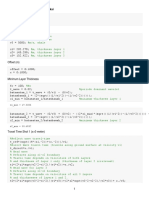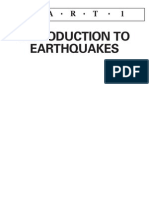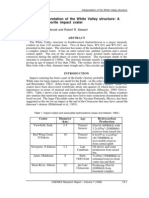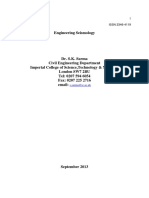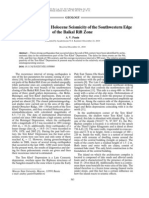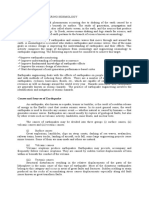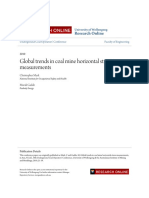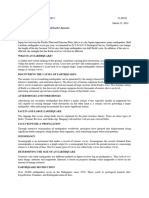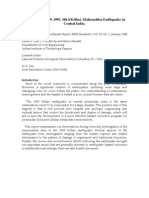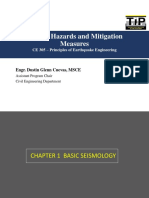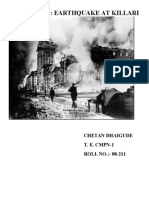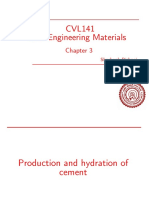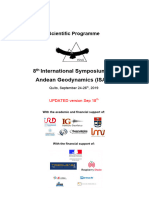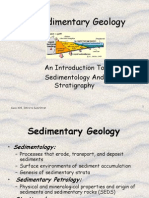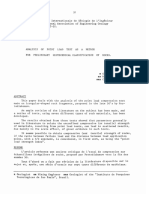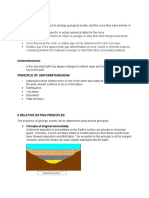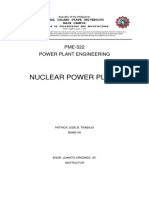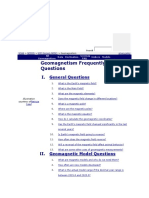Et Al
Et Al
Uploaded by
jusselinoCopyright:
Et Al
Et Al
Uploaded by
jusselinoOriginal Title
Copyright
Share this document
Did you find this document useful?
Is this content inappropriate?
Copyright:
Et Al
Et Al
Uploaded by
jusselinoCopyright:
Bulletinof the SeismologicalSocietyof America. Vol. 61, No. 5, pp. 1453-1466.
October,1971
VIOLENT DEFORMATION OF ROCK NEAR DEEP-LEVEL, TABULAR EXCAVATIONS--SEISMIC EVENTS BY ARTHUR MCGARR ABSTRACT
Inelastic deformation of the rock near the edges of the thin tabular excavations (stopes) of deep-level mines sometimes occurs violently, resulting in a seismic event. These seismic events are produced in the highly-stressed rock near the edges of the stopes and appear to be the result of shear failure across a plane; these conclusions are based on seismic as well as underground observations. The seismic events occurring near stopes can be described using a model based on the theory of dislocations; they result from two edge dislocations of opposite sign annihilating each other and releasing energy. The instantaneous convergence of the stope that is observed to occur at the time of a large mine tremor is compatible with the observed seismic energy of the tremor, according to analysis based on the dislocation model.
INTRODUCTION
This paper reviews observations concerning the violent deformation of rock surrounding some gold mines on the Witwatersrand and then discusses the observations in the light of a model of rock deformation that was presented in a companion paper (MeGarr, 1971). As Jaeger and Cook (1969) have noted, the formation of an excavation at great depth generally stresses portions of the surrounding rock mass beyond its elastic limit resulting in failure; this failure may occur in a continuous, nonviolent manner or violently. To date, the mining industry has not been successful in eliminating the occurfence of violent failures although much research over the years, summarized by Cook et al. (1966), has indicated many methods of either minimizing the occurrence of such failures or lessening their effects on the underground workings. A small percentage of the violent failures or seismic events manifest themselves as damage to the underground workings beyond that caused simply by falling rock (Cook, 1963). Such events, known as rockbursts, are by far the most serious cause of loss of life as well as production in the deep mines. OBSERVATIONS Background concerning gold mines on the Witwatersrand and terminology used to described various features of the mines has been presented by MeGarr (1971) and is assumed in this paper. Mining proceeds by enlarging the thin, tabular excavations, called stopes; generally, the edge or face of the stope is advanced subparallel to the strike of the gold-bearing reef. As the face is advanced, the rock in the vicinity of the face is stressed beyond its elastic limit and is deformed inelastically. The intent of this section is to review data that appear to be crucial to obtaining an understanding of the conditions associated with the transition from continuous to violent failure and to a physical description of the violent failure. Most of the observations discussed here have been made at East Rand Proprietary Mines, Limited (ERPM), currently the deepest gold mine in the world and a mine with a particularly serious roekburst problem. 1453
1454
BULLETIN
OF T H E S E I S M O L O G I C A L S O C I E T Y OF A M E R I C A
Cook (1963) showed that nearly all seismic foei occur close to the stope face and that the pattern of seismieity follows the contour of the advancing face quite closely. Cook (1963) found that the energy radiated in the seismic waves of events detected by his seismic network ranged from about 101 to 1016 ergs. Cook's (1963) largest events are equivalent in seismic energy to earthquakes with a Richter magnitude of 3. Cook (1963) also found that most of the seismic events occur shortly after blasting, which occurs between 2 and 5 p.m., 6 days a week. To date, seismic data indicate that mine tremors are physically very similar to earthquakes. For instance, Gane et al. (1946) noted that the shear phase is generally quite prominent on seismograms of mine tremors; in fact, the shear wave usually has at least several times as much amplitude as the eompressional wave. This suggests a mechanism similar to that of earthquakes, namely, shear failure along a plane. Mine tremors also obey the same magnitude-frequency relation as earthquakes, that is, logN = a + bM (1)
where N is the number of events of magnitude M or greater occurring in a given time interval, a is a constant, and b is of the order of - 1 . Figure 1 shows magnitude-frequency data for events recorded for a period of 1 year at Harmony Gold Mine. These data were derived from a table showing the frequency of events as a function of seismic energy compiled by Joughin (1966) ; seismic energies were converted to magnitude using l o g E = 11.8 -]- 1 . 5 M (2)
where E is the energy in ergs (Richter, 1958). For earthquakes, b ranges from about - 0 . 5 to - 1 . 5 (Richter, 1958) so the value of b of - 1 . 2 deduced from the data of Figure 1 is a reasonable value for a set of earthquakes. Hodgson and Cook (1970) have found that b = - 1 . 4 for seismic events recorded over a large portion of E R P M . Hodgson (1967), in the course of measuring the convergence of stopes (Figure 2A), found two types of convergence--continuous and discontinuous, as illustrated in Figure 2B. Hodgson associated the steps in convergence with located seismic events. He found that, when a large seismic event occurs near a convergence meter, there is an instantaneous step in convergence followed by a period of unusually rapid convergence which gradually slows to the secular rate of convergence (Figure 2C). Underground observations indicate that mine tremors are the result of violent shear failure across a plane; planar zones of severely eomminuted quartzite, known as "burst fractures," have been correlated with large seismically recorded events (Spottiswoode and ~eGarr, 1970). Figure 3A shows a burst fracture that was correlated with a seismic event that radiated about 8 X 1015 eras of seismic energy. Figure 3A also shows the normal type of fractures that form in the vicinity of a stope face; they dip from u p p e r left to lower-right. Figure 3B is a schematic diagram that illustrates the geometry of these two types of fractures. Kersten (1964), in an extensive study, divided the fractures that occur near tabular excavations into three eatagories--elass 1, class 2 and class 3. His class 1 fractures correspond to the type 1 planes of Figure 3B. His class 3 fractures correspond to the type 2 planes of Figure 3B, and his class 2 planes seem to be intermediate in appearance between types 1 and 2. The underground observations of the present study indicated that an intermediate classification of fractures is not warranted.
VIOLENT DEFORMATION OF ROCK NEAR DEEP-LEVEL STOPES--SEISMIC EVENTS
1455
Both types of fractures (Figure 3B) are planar features that strike parallel to the face. In the hangingwall, the burst fractures dip toward the stope whereas the normal fractures dip away from it (Figure 3B). The shear displacement across a burst fracture is such that the block on the stope side has moved down for fractures in the hangingwall and up for fractures in the footwall; that is, burst fractures appear to be associated with instantaneous convergence of the stope (Figure 2C). Underground observations indicate that in the vicinity of a burst fracture the normal fractures are unusually sparse. In stopes where the typical separation of normal fractures may be of the order of 5 cm, the separation near a burst fracture is of the order
~4
Log N 2
,,/
M FIG. 1. F r e q u e n c y - m a g n i t u d e plot for seismic events occurring in H a r m o n y Gold Mine. N is the number of events of magnitude M or greater t h a t occur in one year.
of 25 em (Spottiswoode and McGarr, 1970). This suggests that burst fractures are associated with a poorly-developed "fracture zone." Another clue regarding the mechanism of burst fractures is provided by the observation that burst fractures in the hanging~vall do not continue into the footwall (Spottiswoode and ~eGarr, 1970). Even burst fractures that occur ahead of the face seem to terminate abruptly in the projected plane of the stope.
ANALYSIS
Hitherto, seismic events associated with gold mining have received only limited theoretical analysis. 5lost theories concerned with deformation in the vicinity of stopes surrounded by strong, brittle rock are based on the assumption of a perfectly elastic rock mass (e.g., Cook, 1963; Salamon, 1965). Elastic theory has been used to estimate the energy released per unit increase in the area of a stope for various mining configurations. Hodgson and Joughin (1966) demonstrated empirically that high energy-release rates are associated with more serious rockburst problems. The energyrelease rate is currently regarded as one of the most important parameters in planning a mining geometry (Cook et al., 1966). This elastic theory, however, is of little value in
1456
BULLETIN
OF
THE
SEISMOLOGICAL
SOCIETY
OF
AMERICA
understanding the mechanism of mine tremors as they are clearly inelastic phenomena. I n one of the few inelastic treatments of the problem of rock deformation around underground excavations, Deist (1965) treated the rock mass as a nonlinear continuum. His approach acknowledges the existence of a zone of fractured rock around tunnels and stopes but ignores the regular geometry of the fracture patterns, described by
A
I(
Span HangJngwall
Fo~,~
Convergence Meter
Footwall
13
o~%~ ~U~s ce
z 0 Con~e~a~
TIME
..~
iS
J
~.~
TIME
FIG. 2, A. Schematic diagram of cross-section through stope showing position of convergence meter. The convergence meter is anchored about 15 m into the hangingwall and footwall. B. Schematic diagram showing two types of convergence observed by Hodgson (1967). C. Diagram showing burst convergence and accelerated rate of convergence following burst. Kersten (1964) and of the burst fractures (Figure 3). Although Deist's nonlinear approach m a y yield more sophisticated criteria for the occurrence of violent failures, it appears unlikely to provide much insight into the actual physics of either continuous or violent failure. A model based on the theory of dislocations, on the other hand, m a y offer a more appropriate simulation of violent and nonviolent rock deformation. Briefly, the stope and the inelastic deformation t h a t occurs in the surrounding rock are represented as dislocations t h a t move as a result of interactions of dislocations with other dislocations and with the virgin stress field (McGarr, 1971). The use of macroscopic dislocations to represent rock deformation around stopes is quite similar to their use in describing
VIOLENT DEFOR~IATION OF ROCK NEAR DEEP-LEVEL STOPES---SEISMIC EVENTS
1457
STOPE
\ \
FIG. 3, A. Photograph showing burst fracture dipping from upper" right to lower left and ordinary or type 1 fractures dipping from upper left to lower right (Courtesy of W. D. Ortlepp.) B. Schematic diagram showing type 1 and type 2 fractures. The dotted rectangle shows the position of Figure 3A. cracks (e.g., Bilby and Eshelby, 1968), and considerable use has been made in ~[cGarr (1971) and this paper of results from studies of crack propagation. ~"[aeroscopic dislocations have also been used to describe various phenomena associated with earthquakes. Ground deformation has been calculated by representing
1458
BULLETIN OF THE SEISMOLOGIC2~.L SOCIETY OF AMERICA
earthquakes as dislocation processes (e.g., Steketee, 1958; Weertman, 1964, 1965; Savage and Hastie, 1966). A dynamic description of earthquake mechanisms in terms of dislocations has been presented by Droste and Teisseyre (1960) and attempts to explain sequences of earthquakes using dislocation theory have been made by Teisseyre (1964) and Kasahara and Teisseyre (1966). Because the seismic events that occur in gold mines appear to be similar to earthquakes, it seems reasonable that they also can be modeled by means of dislocations. Figure 4 illustrates the dislocation reactions that are presumed to occur in the model of an island-are system by Droste and Teisseyre (1960) and the model of a mine stope as presented in McGarr (1971). Figure 4A, a diagram of the model proposed by Droste and Teisseyre (1960), shows two centers of creation of dislocations. Edge dislocations move outward in the direction of the arrows. When two dislocations of the same size and of opposite sign get close enough, they accelerate toward each other under the influence of a mutually attractive force and finally annihilate themselves releasing all of the energy associated with the two dislocations. Similarly, a dislocation can accelerate toward a free surface and can release much energy as it deforms the surface as shown in Figure 4A. According to Droste and Teisseyre (1960), large earthquakes can be represented as dislocation-annihilation reactions and smaller events are represented as movements of dislocations. Figure 4B and 4C illustrates the model developed in McGarr (1971). The stope is represented as dislocations piled up against the face under the influence of the virgin lithostatic stress. The shear stresses induced by the piled-up dislocations exceed the elastic limit of the rock near the face and cause dislocation motion along one of two possible shear planes. Figure 4]3 shows "type 1" dislocation motion in which dislocations of approximately the same type as the stope dislocations move into the plane of the stope from the highlystressed regions above and below the face. The horizontal components of the dislocations from above and below cancel, releasing energy, and the vertieM components add to yield a dislocation of the same type as those representing the stope; the plane of the stope is an equilibrium position for these dislocations. It was shown in McGarr (1971) that an array of "type 1" dislocations ahead of the face can be very effective in relaxing the intense stresses induced by the stope. Figure 4C shows another type of dislocation reaction that may occur near the face. The conjugate shear stress to that shown in Figure 4B moves a dislocation having approximately the opposite sign as the stope dislocation iuto the plane of the stope. The Burgers vector of the "type 2" dislocation cancels part of the type 1 dislocation, already in the plane of the stope, and considerable energy is released. The macroscopic dislocations of Figure 4, B and C damage the rock because of the high stresses near the cores of the dislocation lines and, thus, leave a track as they move through the rock. The type 1 dislocation movement of Figure 4B generates normal fracture planes and the type 2 movement results in abnormal planes, some of which are identified as burst fractures (Figure 3). For the remainder of this section, the phenomena of mine tremors, described in the previous section, are discussed vdthin the framework of the model shown in Figure 4C. Energy release and convergence. Droste and Teisseyre (1960) used a dislocation model of an earthquake to relate the energy released by a shock to its fault displacement. Similarly the dislocation model of McGarr (1971) can be used to relate the instantaneous convergence that Hodgson (1967) correlated with seismic events (Figure 2)
VIOLENT DEFORMATION
OF R O C K N E A R D E E P - L E V E L
STOPES--SEISMIC
EVENTS
1459
C
J l I--
/:
FIG. 4, A. The dislocation motion presumed to occur in island-are regions according to Droste and Teisseyre (1960). B. Dislocations representing the stope and type 1 dislocations that are created in the region of high shear stress and move into the plane of the stope to form a "fracture zone." C. Motion of the type 2 dislocations in the hangingwall and footwall. In the footwall, the type 2 dislocation has accelerated into the stope and caused instantaneous convergence. In the hangingwall, a seismic event is about to occur some distance ahead of the face. to t h e seismic energies of these events. T h r e e of t h e seismic events, s t u d i e d b y H o d g s o n a n d listed in T a b l e 1, were l o c a t e d sufficiently close to a c o n v e r g e n c e m e t e r so as to be a m e n a b l e to a n a l y s i s using t h e t w o - d i m e n s i o n a l m o d e l a s s u m e d here. A l l of t h e e v e n t s r a d i a t e d a b o u t 1013 ergs of seismic energy, a c c o r d i n g to H o d g s o n , a n d so i t seems l i k e l y t h a t these e v e n t s are a s s o c i a t e d w i t h d i s l o c a t i o n m o t i o n a l o n g t y p e 2 p l a n e s ( F i g u r e
40).
If a d i s l o c a t i o n of B u r g e r s v e c t o r b, w i t h sign o p p o s i t e to t h e B u r g e r s v e c t o r of t h e s t o p e dislocations ( F i g u r e 4C), m o v e s i n t o t h e p l a n e of t h e s t o p e in t h e v i c i n i t y of t h e
1460
BULLETIN
OF THE
SEISMOLOGICAL
SOCIETY
OF AMERICA
face, it annihilates stope-like dislocations; this process results in instantaneous convergence and release of energy. Instantaneous convergence occurs because, in order to maintain a stress-free surface around the stope, dislocations having a total Burgers vector of b must immediately climb from the center of the stope to the point of the annihilation reaction to maintain the original dislocation distribution (MeGarr, 1971). I t was shown in M c G a r r (1971) t h a t the convergence at a given point is equal to the total number of dislocations t h a t climb past t h a t point and so an annihilation reaction in the stope of strength b results in an instantaneous convergence of b. If the type 2 reaction occurs ahead of the face, then the instantaneous convergence is less t h a n if it occurs in the stope because the stress field within the stope is less affected; thus, less dislocation climb is required to maintain the stress-free surface around the stope. To illustrate this point, consider a model of a stope and fracture zone derived in 54[cGarr (1971), referred to as model 4, which is a hypothetical stope with a span of 600 m at a depth of 3 km. Model 4 has a "fracture zone" that extends 10 m ahead of the face composed of dislocations having a density of 0.01 (equivalent to one dislocation every meter with a Burgers vector of 1 cm). A seismic event or type 2 reaction was simulated iust ahead of the face b y assuming t h a t all of the dislocations TABLE 1
MEASURED SEISMIC ENERGY AND SEISMIC E N E R G Y PREDICTED FROM CONVERGENCE Event number Convergence (cm) Seismic Energy Theoretical total Theoretical seismic (ergs) energy release (ergs) energy (ergs)
2 7 10
0.15 0.13 0.57
10la 1013 1013
3,8 X 1014 3.1 X 1014 4.2 X 101~
6.5 X 101~ 5.3 X 101= 7.1 X 10la
in the first meter ahead of the face were annihilated; that is, the type 2 dislocation was assumed to have a Burgers vector of 1 cm. Computation of the convergence before and after this reaction indicated an instantaneous convergence of 0.56 cm. A type 2 reaction farther ahead of the face would have yielded less convergence because less adjustment of the stope dislocations would have been necessary to maintain the stressfree surface. For purposes of analyzing the events recorded by Hodgson, we assume that the seismic events occur just ahead of the face; that is, the instantaneous convergence is half of the Burgers vector of the type 2 dislocation. The locations shown by I-Iodgson (1967) for the three events under consideration are consistent with this assumption within the accuracy of his locations, but, unfortunately, this accuracy is only about 15 m. In a type 2 reaction, energy is released (Droste and Teissyre, 1960) according to
W-
2rr(1 -
v)
lnr0- --
)'b2
(3)
where G is the modulus of rigidity, ~ is Poissons ratio, L is the distance from the plane of the stope at which the dislocation begins accelerating, r0 is the radius of the dislocation line, X is the length of the dislocation line, and b is its Burgers vector. Table 1 lists event numbers used by Hodgson (1967), convergences, seismic energies, energies corn-
V I O L E N T D E F O R M A T I O N OF R O C K N E A R D E E P - L E V E L S T O P E S - - S E I S M I C E V E N T S
1461
puted using (3), and theoretical seismic energies. To compute energies using (3), it is necessary to estimate L, r0, and X; b is assumed to be twice the convergence listed in Table 1. To estimate L, we assume that the type 2 dislocations are created in the middle of the zone of high shear stress. The center of this zone is about 5 m above the plane of the stope according to Figure 9 of McGarr (1971), so L is taken to be 5 m. r0, the radius of the dislocation line is taken to be 5b on the basis of underground observations of burst fractures (Spottiswoode and 5IeGarr, 1970). X is the length of a stope panel, about 100 m in E R P M ; this assumption is supported by underground observations by Spottiswoode and McGarr (1970). Finally, G = 4 X 1011dynes/era 2 and 27r(1 - v) ~ 5. The theoretical seismic energies were calculated by multiplying the energy computed from (3) by a seismic efficiency factor, q. q is estimated from a relationship given by Bath and Duda (1964). log q = --2.00 d- 0.23 M (4)
where M is the Richter magnitude. The magnitude of the events of Table 1 can be estimated using (2). Seismic energies of 1013 ergs correspond to M ~ 1 which, in turn, corresponds to q = 0.017 from (4). We see in Table 1 that the theoretical seismic energies, computed from the eonvergences, are in reasonable agreement with those estimated by Hodgson indicating t h a t the measurement of energy and convergence are consistent according to the model of Figure 4C. I t should be noted, however, that (4) is a somewhat controversial relation (King, 1969) and so the efficiency of seismic radiation for the events of Table 1 may be more or less than 0.017. No better knowledge of q exists at this time, however. Conditions for type 2 reactions. There are two types of observations that suggest that large seismic events are associated with inhibited or insufficient movement of type 1 dislocations. The underground observations of Spottiswoode and McGarr (1970) indicate unusually large separations between normal and type 1 fracture planes near a burst fracture. Hodgson (personal communication) has evidence suggesting that the rate of stope convergence decreases prior to a large seismic event; this can be taken as indicating inhibited type 1 movement., as it was shown in McGarr (1971) that the rate of continuous convergence is proportional to the flux of type 1 dislocations into the plane of the stope. There are also several observations that suggest that a violent failure promotes the movement of type 1 dislocations. Hodgson (1967) (Figure 2C) showed that convergence occurs at a higher than normal rate, for a period of the order of four hours following a seismic event. Figure 5 shows the corresponding underground observations. Figure 5 is a view from about 1.5 m of a burst fracture that was presumably related to stoping that progressed from left to right about 11 m above. We see that smaller fractures having the appropriate orientation of type 1 fractures in the footwall have apparently been nucleated by the large type 2 or burst fracture. If this analysis is correct, then the burst fracture has effectively weakened the quartzite and, thus, facilitated plastic deformation or type 1 movement. Generally, the propensity of the rock to undergo type 1 deformation appears to be a property of the rock. For instance, the argillaceous quartzites found in the Harte-
1462
BULLETIN OF THE SEISMOLOGICAL SOCIETY OF AMERICA
beestfontein Gold FIine appear to undergo type 1 deformation much more easily than the much stronger and more brittle quartzites at E R P M (P. P. Venter and 1%. W. O. Kersten, personal communication, 1970). The presence of strong brittle dykes is often associated with poorly-developed fracture zones and large seismic events. Thus, the development of a fracture zone appears to depend partially on the strength and brittleness of the surrounding rock.
FIO. 5. B u r s t f r a c t u r e t h a t has a p p a r e n t l y nucleated t y p e 1 fractures. T h e t y p e 1 fractures dip from upper right to lower left. (Courtesy of W. D. Ortlepp.)
Another variable that appears to affect the development of the fracture zone is the rate of face advance. Cook et al. (1966) stated that beyond a certain rate of advance, varying from about 5 to 8 m per month, the incidence of rockbursts increases. The critical rate of face advance probably depends at least partially on the inelastic properties of the rock. The dislocation model developed in ~/[cGarr (1971) provides a useful framework for discussing processes that may occur prior to and following a large seismic event. Assume that a face is being advanced through a zone of particularly strong and brittle rock, which inhibits the formation of the fracture zone; for example, a strong brittle dyke may be in the vicinity of the face. Because of inadequate migration of type 1 disloca-
VIOLENT DEFORMATION OF ROCK NEAR D E E P - L E V E L S T O P E S - - S E I S M I C EVENTS
1463
tions into the plane of the stope, the stress near the face increases until type 2 deformation finally occurs in response to the high stress field. The type 2 reaction of Figure 4C could be considered as a "short-circuit" of the type 1 process of Figure 4B. Whereas type 1 movement is accommodated by convergence some distance behind the face in the mined-out region, type 2 movement is accommodated by convergence at the point of failure. An electrical analogy might be the phenomenon of arcing across an overloaded pair of conductors.
FIG. 6. Burst fracture in footwall due to stoping that progressed from left to right about 11 m above. The conglomerate horizon in lower half of picture indicates that the left side of the burst fracture has moved up by about 2.5 cm with respect to the right side. (Courtesy of W. D. Ortlepp.) After the occurrence of the seismic event, type 1 deformation occurs at an unusually high rate because the zone of comminuted rock along the burst fracture facilitates the generation of type 1 planes. The hypothetical interaction of a stope with the surrounding rock discussed here has an interesting analogy on the smaller scale of crack propagation. Experimental observations of dislocations mJcleated near the tips of cracks propagating in a tensile stress field indicate that more dislocations are nucleated when the crack propagates slowly. The dislocations are particularly concentrated in regions where the crack tip stops (e.g., Figure 1 of Tetelman and Robertson, 1963).
1464
BULLETIN
OF TItE
SEISMOLOGICAL
SOCIETY
OF AMERICA
Source mechanism. Consider a type 2 dislocation line that is 100 m long and some distance L above or below the stope face; the dislocation is presumably created in the zone of high shear stress so L is of the order of 5 to 10 m. Such a dislocation line will at some point accelerate into the plane of the stope and release energy according to (3). I t is possible to estimate the time required for the energy release by considering some fundamental properties of dislocation lines. A dislocation line is analogous, in some respects, to a string under tension. It has a line tension of about 0.5ub 2 (Cottrell, 1953, p. 53) and a linear density of about pb ~ (Cottrell, 1964) where p is the density of the material. Thus, the velocity of wave propagation along a dislocation line is
V
,/ub 2 _ 2pb 2 "~/'2
where ~ is the velocity of shear waves in the medium, about 3.6 km/sec in quartzite. Thus, v ~ 2.5 km/sec. The type 2 fracture, then, is initiated at some point along the stope where the dislocation line first accelerates into the plane of the stope. From this point the rupture propagates in both directions parallel to the stope face with a velocity of about 2.5 kin/see until the entire dislocation line has been annihilated. The minimum time for this process corresponds to rupture initiation at the center of the stope panel and the maximum time corresponds to initiation at either end. For a dislocation line that is 100 m long, the minimum and maximum times for the rupture process are 20 msec and 40 msec, respectively. These estimates are in good agreement with evidence presented by Cook (1963). He noted that records of events close to the seismometers showed that the major release of energy occurs up to 20 msec after the detection of the first arrivals. This is probably the time taken for the failures to develop, according to him. The observed time of 20 msee is in best agreement with the assumption that the rupture is initiated at the center of the stope. The seismic focal-mechanism study of Spottiswoode and McGarr (1970) has provided some crucial evidence in favor of the mechanism shown in Figure 4C. All eleven events studied by them had focal mechanisms appropriate for slip across normal faults in agreement with the mechanism of Figure 4C. DISCUSSION It should be noted that, although the model of this paper provides a basis for describing most of the seismic events associated with stoping, there are some events that are not amenable to such analysis. Seismic events that occur more than about 20 m from the stope cannot be explained using the model of Figure 4C, hut, nevertheless, occur according to Cook (1963) and Joughin (1966). There are many possible explanations for such events. For instance, mining may trigger shear failure across pre-existing faults, which are found in the rock surrounding the gold mines. The presence of an unusually weak layer of rock in the hangingwall or footwall may be a source of seismic events; elastic deformation in the rock caused by stoping could be converted to inelastic deformation, including seismic events, in a weak layer. Both observation and theory indicate that, when the type 1 fractures are unusually sparse, the shear stress in the vicinity of the face has not been sufficiently relaxed and may be dangerously high; the presence of type 2 fractures can be interpreted similarly. The apparent nucleation of type 1 fractures along type 2 planes, shown in Figure 5,
VIOLENT DEFORMATION OF ROCK NEAR DEEP-LEVEL STOPES--SEISMIC EVENTS
1465
suggests that a zone of comminution reduces the effective strength of the rock and allows the "fracture zone" to develop more easily. If a means could be found to artificially create such a comminuted zone in regions where the fracture zone has not developed properly, then, the risk of a large seismic event might be reduced.
ACKNOWLEDGMENTS I wish to thank Professor L. O. Nicolaysen for much encouragement and advice during the course of this study and for reviewing the manuscript. Mr. W. D. Ortlepp of East Rand Proprietary Mines, Limited, and Mr. A. J. White of the Mining Research Laboratory of the Transvaal and Orange Free State Chamber of Mines provided valuable suggestions during the course of discussions on the surface and underground. Dr. James C. Savage of the U. S. Geological Survey reviewed the manuscript. This research was sponsored by the Chamber of Mines of South Africa.
I~EFERENCES B~th, M. and S. J. Duda (1964). Earthquake volume, fault plane area, seismic energy, strain deformation, and related quantities. Ann. Geofis. (Rome) 17,353-368. Bilby, B. A. and J. D. Eshelby (1968). Dislocations and the theory of fracture, in Fracture, Liebowitz, H., Editor, Vol. I, Academic Press, New York. Cook, N. G. W. (1963). The seismic location of rockbursts, Proceedings of the Fifth Rock Mechanic~ Symposium, Pergamon Press Oxford, 463-516. Cook, N. G. W., E. Hoek, J. P. G. Pretorius, W. D. Ortlepp, and M. D. G. Salamon (1966). Rock mechanics applied to the study of rockbursts, J.S. Afr. Inst. Min. Metall. 65,435-528. Cottrell, A. If. (1953). Dislocations and Plastics Flow in Crystals, Clarendon Press, Oxford. Cottrell, A. H. (1964). Theory of Crystal Dislocations, Blackie, London. Deist, F. H. (1965). A nonlinear continuum approach to the problem of fracture zones and rockbursts, in Rock Mechanics and Strata Control in Mines, S. Aft. Inst. Min. Metall., Johannesburg. Droste, S. and R. Teisseyre (1960). The theory of dislocation processes and its application to the Pacific region, Bull. Seism. Soc. Am. 50, 57-70. Gane, P. G., A. L. Hales, and H. A. Oliver (1946). A seismic investigation of the Witwatersrand earth tremors, Bull. Seism. Soc. Am. 35, 49-80. Hodgson, K. (1967). The behaviour of the failed zone ahead of a face, as indicated by continuous seismic and convergence measurements, C.O.M. Research Report No. 31/67, Transvaal and Orange Free State Chamber of Mines Research Organisation, April. Hodgson, K. and N. C. Joughin (1966). The relationship between energy release rate, damage and seismicity in deep mines, C.O.M. Research Report No. 57/66, Transvaal and Orange Free State Chamber of Mines Research Organisation. Hodgson, K. and N. G. W. Cook (1970). The mechanism, energy content and radiation efficiency of seismic waves generated by rockbursts in deep level mining, paper presented at the Conference on Dynamic Waves in Civil Engineering at Swansea in July. Jaeger, J. C. and N. G. W. Cook (1969). Fundamentals of Rocl Mechanics, Methuen, London. Joughin, N. C. (1966). The measurement and analysis of earth motion resulting from underground rock failure, Ph.D. Thesis, University of the Witwatersrand, Johannesburg, South Africa. Kasahara, K. and R. Teisseyre (1966). A dislocation model of earthquake swarms, Bull. Earthquake Res. Inst., Tokyo Univ. 44,793-810. Kersten, R. W. O. (1964). Report on Chamber of Mines Project No. 111/64/10108, Transvaal and Orange Free State Chamber of Mines Research Organisation. King, C. Y. (1969). Seismic efficiency, J. Geophys. Res. 74, 1702-1703. McGarr, A. (1971). Stable deformation of rock near deep-level tabular excavations, J. Geophys. Res. (in press). Richter, C. F. (1958). Elementary Seismology, W. H. Freeman, San Francisco. Salamon, M. G. D. (1965). Elastic analysis of displacements and stresses induced by the mining of seam or reef deposits, in Rock Mechanics and Strata Control in Mines, S. Aft. Inst. Min. Metall., Johannesburg. Savage, J. C. and L. M. Hastie (1966). Surface deformation associated with dip-slip faulting, J . Geophys. Res. 71, 4897-4904.
1466
BULLETIN OF THE SEISMOLOGICAL SOCIETY OF AMERICA
Spottiswoode, S. and A. McGarr (1970). Focal mechanisms of seismic events in deep-level gold mines (in preparation). Steketee, I. A. (1958). Some geophysical applications of the elasticity theory of dislocations, Can. J. Phys. 36, 1168. Teisseyre, R. (1964). Dislocation systems and their interaction in shock sequence, Acta Geophys. Polon. 12, 23-36. Tetelman, A. S. and W. D. Robertson (1963). Direct observation and analysis of crack propagation in iron--3% silicon single crystals, Aura. Met. 11,415-426. Weertman, J. (1964). Continuum distribution of dislocations on faults with finite friction, Bull. Seism. Soc. A~n. 54, 1035-1058. Weertman, J. (1965). Relationship between displacements on a free surface and the stress on a fault, Bull. Seism. Soc. Am. 55,945-953.
BERNARD PRICE INSTITUTE OF GEOPHYSICAL !P~ESEARCH UNIVERSITY OF THE WITWATERSRAND JOHANNESBURG, SOUTH /~FRICA
Manuscript received December 14, 1970.
You might also like
- Forward Modelling Seismic Refraction MatlabDocument8 pagesForward Modelling Seismic Refraction MatlabaisyanrhfyyaNo ratings yet
- Lecture 5 Elastic Rebound Theory PDFDocument6 pagesLecture 5 Elastic Rebound Theory PDFHari Ram0% (1)
- 1 5engineering SeismologyDocument40 pages1 5engineering SeismologyGk BhaneshNo ratings yet
- 14498Document27 pages14498Zig BlankNo ratings yet
- Eost17232 PDFDocument5 pagesEost17232 PDFgeotopgunNo ratings yet
- Introduction To Earthquakes: P A R T 1Document26 pagesIntroduction To Earthquakes: P A R T 1Tojo RanaNo ratings yet
- Evaluation of Blast-Induced Ground Vibration PredictorsDocument10 pagesEvaluation of Blast-Induced Ground Vibration Predictorshusam mahdiNo ratings yet
- Chapter 4 Quantification of Seismic AccelerationDocument5 pagesChapter 4 Quantification of Seismic AccelerationkkgbkjNo ratings yet
- The Distribution of B-Value in Different Seismic Provinces of IranDocument8 pagesThe Distribution of B-Value in Different Seismic Provinces of IranHemen GogoiNo ratings yet
- Lecture 6 PDFDocument11 pagesLecture 6 PDFsunilaanserNo ratings yet
- Bssa 0650010093Document20 pagesBssa 0650010093363331272No ratings yet
- 3.1 Introduction To Seismic Sources and Source ParametersDocument94 pages3.1 Introduction To Seismic Sources and Source Parameterssuman subediNo ratings yet
- Causes For Triggered Earthquakes - A Recent Review: R.Samuel Selvaraj and B.UmamaheswariDocument5 pagesCauses For Triggered Earthquakes - A Recent Review: R.Samuel Selvaraj and B.UmamaheswariRakeshconclaveNo ratings yet
- EarthquakeDocument39 pagesEarthquakeMbiko Sabeyo0% (1)
- Sud America GeofisicaDocument9 pagesSud America GeofisicacarlodolciNo ratings yet
- Earthquakes: Soil DynamicsDocument21 pagesEarthquakes: Soil DynamicsJulNo ratings yet
- Hans-Henrik Westbroek and Robert R. Stewart - Seismic Interpretation of The White Valley Structure: A Possible Meteorite Impact CraterDocument18 pagesHans-Henrik Westbroek and Robert R. Stewart - Seismic Interpretation of The White Valley Structure: A Possible Meteorite Impact CraterJuaxmawNo ratings yet
- Engineering Seismology: 1 ISSN 2346-4119Document40 pagesEngineering Seismology: 1 ISSN 2346-4119Haider ShahNo ratings yet
- Assessment of Rockfall Hazard at Base of Talus SlopeDocument17 pagesAssessment of Rockfall Hazard at Base of Talus Slopet.w.c.No ratings yet
- Bolted Connections ProbsDocument25 pagesBolted Connections ProbsOuseppachan AmbookenNo ratings yet
- Case StudyDocument11 pagesCase StudyHomework PingNo ratings yet
- Chapter 4 Quantification of Seismic Acceleration: 4.1 BackgroundDocument3 pagesChapter 4 Quantification of Seismic Acceleration: 4.1 BackgroundkkgbkjNo ratings yet
- Ondas Sismicas ¿Como Leer El Sismografo?Document5 pagesOndas Sismicas ¿Como Leer El Sismografo?Bianny RemolinaNo ratings yet
- EarthquakeDocument34 pagesEarthquakeRahul ShahNo ratings yet
- Coulomb Stress Changes in The Gulf of Corinth (GREECE) FOR THE 1992-1995 PERIODDocument10 pagesCoulomb Stress Changes in The Gulf of Corinth (GREECE) FOR THE 1992-1995 PERIODHectoreRodriguezlNo ratings yet
- Sources of Tsunami and Tsunamigenic Earthquakes in Subduction ZonesDocument17 pagesSources of Tsunami and Tsunamigenic Earthquakes in Subduction ZonesNada KamiliaNo ratings yet
- 1 Sismo DinSol20232Document57 pages1 Sismo DinSol20232andesNo ratings yet
- Fonds: Documenfagr@Document4 pagesFonds: Documenfagr@doki dokiNo ratings yet
- Eps 2011 10 006-1Document5 pagesEps 2011 10 006-1Riska MajitNo ratings yet
- Improving The Resistance of Structures To EarthquakesDocument53 pagesImproving The Resistance of Structures To EarthquakesfirterNo ratings yet
- Kelleher - Rupture - Zone.of - Large - 1972Document17 pagesKelleher - Rupture - Zone.of - Large - 1972Daniel OlceseNo ratings yet
- Ge162 KanamoriDocument427 pagesGe162 Kanamoriira kusumaNo ratings yet
- 2011 Panin A.V. New Data On The Late Holocene Seismicity of The Southwestern Edge of The Baikal Rift ZoneDocument6 pages2011 Panin A.V. New Data On The Late Holocene Seismicity of The Southwestern Edge of The Baikal Rift ZoneavpaninNo ratings yet
- Barbour Et Al-2019-Geophysical Research LettersDocument4 pagesBarbour Et Al-2019-Geophysical Research LettersmichgebNo ratings yet
- Figure 1. Faulting Map of Mendoza City, Argentina (Segemar)Document22 pagesFigure 1. Faulting Map of Mendoza City, Argentina (Segemar)Francisco CalderonNo ratings yet
- Tonye Geo Assignmt 1-1Document32 pagesTonye Geo Assignmt 1-1Donald Oseghale OkohNo ratings yet
- Influence of Earthquake On Slope StabilityDocument12 pagesInfluence of Earthquake On Slope StabilityEder Gamarra AlvarezNo ratings yet
- Elements of Earthquake SeismologyDocument8 pagesElements of Earthquake SeismologylevyaiiNo ratings yet
- EarthquakesDocument9 pagesEarthquakesAnkitNo ratings yet
- Intraplate EarthquakeDocument4 pagesIntraplate EarthquakenouvemadNo ratings yet
- Frequency and Spatial Distribution of Landslides in A Mountainous Drainage Basin: Western Foothills, TaiwanDocument23 pagesFrequency and Spatial Distribution of Landslides in A Mountainous Drainage Basin: Western Foothills, TaiwanGeorge MireaNo ratings yet
- Lecture 1Document41 pagesLecture 1Sujata SarkarNo ratings yet
- Seismicity of Oceanic and Continental Rifts-A Geodynamic ApproachDocument14 pagesSeismicity of Oceanic and Continental Rifts-A Geodynamic ApproachPeterNo ratings yet
- Chapter 1 Earthquake and Its Impact On Roads and BuildingsDocument9 pagesChapter 1 Earthquake and Its Impact On Roads and BuildingsVivek SharmaNo ratings yet
- Global Trends in Coal Mine Horizontal Stress Measurements: Research OnlineDocument20 pagesGlobal Trends in Coal Mine Horizontal Stress Measurements: Research Onlinekatta_sridharNo ratings yet
- Abolfazlzadeh, McKinnon - 2017 - Stress Field Characterisation in Nickel Rim South Mine Using Seismic Stress InversionDocument10 pagesAbolfazlzadeh, McKinnon - 2017 - Stress Field Characterisation in Nickel Rim South Mine Using Seismic Stress InversionLucas Aguiar VitaNo ratings yet
- Seismically Induced Failure of Rock Slopes: Insights From Field Observations and Analytical ModelingDocument15 pagesSeismically Induced Failure of Rock Slopes: Insights From Field Observations and Analytical ModelingCătălin CăpraruNo ratings yet
- SummarygeoDocument2 pagesSummarygeoimbaako840No ratings yet
- Texte - Géologie BrienzDocument12 pagesTexte - Géologie Brienzns5819No ratings yet
- 1 s2.0 S1365160919307592 MainDocument13 pages1 s2.0 S1365160919307592 MainMatheus Gonçalves Peixoto da SilvaNo ratings yet
- Tunguska Lake ArticleDocument7 pagesTunguska Lake ArticleSandy AllanNo ratings yet
- Seismic Design of Pipeline SystemsDocument20 pagesSeismic Design of Pipeline Systemsjianghf6No ratings yet
- Geophysical Research Letters - 1999 - Axen - Low Angle Normal Fault Earthquakes and TriggeringDocument4 pagesGeophysical Research Letters - 1999 - Axen - Low Angle Normal Fault Earthquakes and Triggeringzulham sugitoNo ratings yet
- Chapter One Introduction To Earthquakes and Earthquakes EngineeringDocument8 pagesChapter One Introduction To Earthquakes and Earthquakes EngineeringAhmed Abd-AlmoujoodNo ratings yet
- EQR KillariDocument17 pagesEQR KillariSiddharth DesaiNo ratings yet
- Tibaldi 1995Document12 pagesTibaldi 1995Gonzalo MaragañoNo ratings yet
- Chapter1 SeismologyDocument101 pagesChapter1 SeismologyJulyNo ratings yet
- Topic 1B - Earth QuakeDocument32 pagesTopic 1B - Earth QuakeXver MLNo ratings yet
- Case StudyDocument11 pagesCase StudyDnyandev ChaudhariNo ratings yet
- Plate Boundaries and Natural HazardsFrom EverandPlate Boundaries and Natural HazardsJoao C. DuarteNo ratings yet
- Earthquakes - PDF To Solve Class 9th IcseDocument4 pagesEarthquakes - PDF To Solve Class 9th IcseAyushmanNo ratings yet
- Fundamentals of Soil ScienceDocument92 pagesFundamentals of Soil ScienceVikas Tiwari100% (1)
- CVL141 Civil Engineering Materials: Shashank BishnoiDocument91 pagesCVL141 Civil Engineering Materials: Shashank BishnoiAdarsh AgrawalNo ratings yet
- Final Exam-Tram TichDocument7 pagesFinal Exam-Tram TichĐậu ChươngNo ratings yet
- FGDC Geolsym PatternchartDocument1 pageFGDC Geolsym Patternchartkasemelk1990No ratings yet
- Sokoria, East Indonesia: A Classic Volcano Hosted Hydrothermal SystemDocument9 pagesSokoria, East Indonesia: A Classic Volcano Hosted Hydrothermal SystemJessica IvanaNo ratings yet
- S11ES IIc D 29Document3 pagesS11ES IIc D 29allanrnmanalotoNo ratings yet
- 1 - Basilica Di San VitaleDocument61 pages1 - Basilica Di San VitaleLam Bao Khanh PhanNo ratings yet
- Bromhead Ring Shear Test Procedure: Geotechnical Testing Journal March 1992Document10 pagesBromhead Ring Shear Test Procedure: Geotechnical Testing Journal March 1992Érica GuedesNo ratings yet
- 2019 ISAG-ProgrammeDocument17 pages2019 ISAG-Programmedayana yaguanaNo ratings yet
- Sedimentary Geology: An Introduction To Sedimentology and StratigraphyDocument19 pagesSedimentary Geology: An Introduction To Sedimentology and Stratigraphysaptak19900% (1)
- Waterlinesfw00 PDFDocument8 pagesWaterlinesfw00 PDFNicole Ann AvenoNo ratings yet
- 5-List-of-Maps Santa RosaDocument3 pages5-List-of-Maps Santa RosaRexbelleNo ratings yet
- Caltrans Geotechnical Manual: Design Acceleration Response SpectrumDocument24 pagesCaltrans Geotechnical Manual: Design Acceleration Response SpectrumMarcos LópezNo ratings yet
- Overview of The Magnetic MethodDocument7 pagesOverview of The Magnetic MethodRoland Rawlins IgaborNo ratings yet
- Explanation TextDocument3 pagesExplanation TextaajunaidiiNo ratings yet
- Guidicini Nieble CornidesDocument16 pagesGuidicini Nieble CornidesAlexandre R. SchulerNo ratings yet
- World GeographyDocument4 pagesWorld GeographyfelixrajasNo ratings yet
- Topographic Map of BastropDocument1 pageTopographic Map of BastropHistoricalMapsNo ratings yet
- EESC101 Plants and OceansDocument14 pagesEESC101 Plants and OceansJohn CaretakerNo ratings yet
- GC Leong - Summary of Arid or Desert Landforms Notes - Study GC Leong For Geography - Summaries & MCQs - UPSCDocument7 pagesGC Leong - Summary of Arid or Desert Landforms Notes - Study GC Leong For Geography - Summaries & MCQs - UPSCshivangiNo ratings yet
- Slope Evolution by MD - Rizwan: Page - 1Document5 pagesSlope Evolution by MD - Rizwan: Page - 1Rashmi KrishnaNo ratings yet
- Relative DatingDocument4 pagesRelative DatingangelicaNo ratings yet
- Project On Stones & TilesDocument41 pagesProject On Stones & TilesMegha GolaNo ratings yet
- Cost Effectiveness of Open-Pit Hard Rock Ore MiningDocument14 pagesCost Effectiveness of Open-Pit Hard Rock Ore Miningpartha das sharma50% (2)
- Nuclear Power PlantDocument14 pagesNuclear Power PlantJessylGuillanoBarbaronaNo ratings yet
- Practice Problems On Soil MechanicsDocument2 pagesPractice Problems On Soil MechanicsHemam PrasantaNo ratings yet
- Geomagnetism Question and AnswerDocument21 pagesGeomagnetism Question and Answerirene299No ratings yet
- Bag Filter Calculation1234567 IPDocument24 pagesBag Filter Calculation1234567 IPsujith kumar100% (1)
